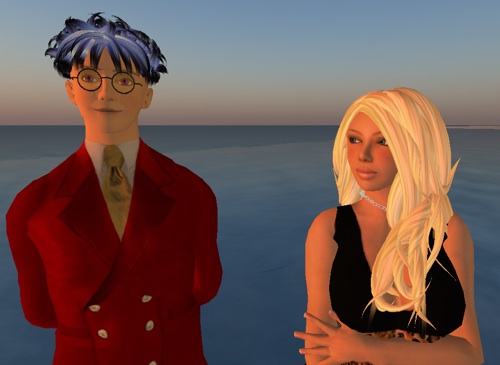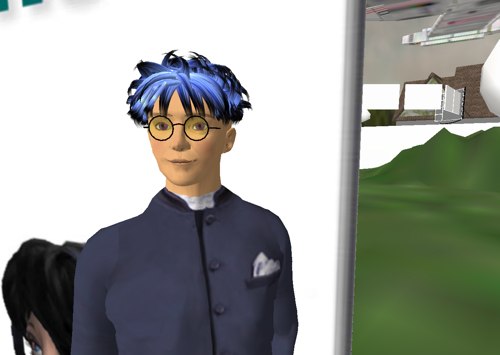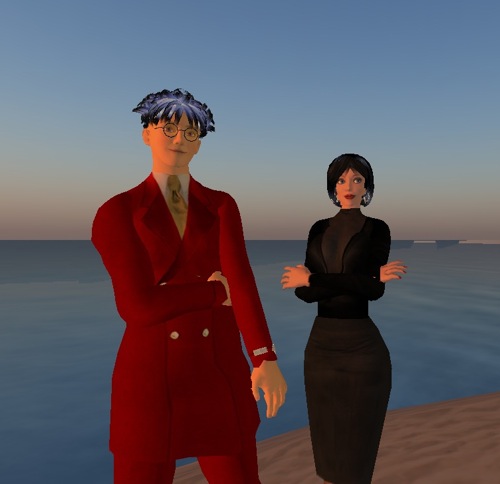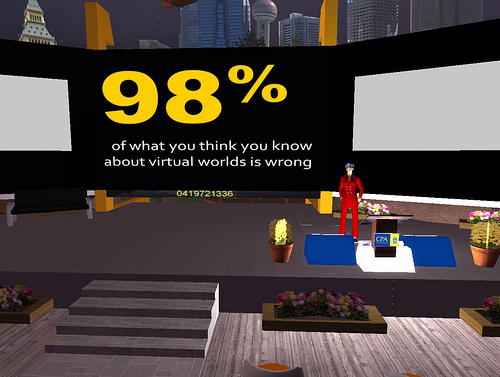Continuing on with our discussion (Part 1 can be found here), we discuss brand identity in virtual worlds, get deep into a discussion of virtual world PhD research and talk about governmental cluelessness.

Lowell: One of the more controversial aspects of business in virtual worlds is brand identity. For regular virtual world users, the overt imposition of brand awareness initiatives can cause some backlash. For business there’s a nearly automatic skepticism of the potential for gains combined with a concern for loss of brand control. How do you see this impasse being solved and which companies to date have done the better job in that regard?
Lee: Fabulous question. Next (laughs). Actually, the whole ‘control’ thing is being played out across social media in general, not just SL, as we all know. What was interesting about the corporate entrance into SL and subsequent backlash was that the corporates just believed that ‘if you build it they will come’, which of course we know just doesn’t work in this new era. When you are the only player in town – the only newspaper, the only tv station, the only record company – there is little choice but for people to come to you, but these days YouTube has usurped TV, iTunes has usurped the record company and many bloggers have audiences far bigger than even the ‘big’ newspaper empires. So these days it is a question of, as Janet Jackson famously sang a couple of decades ago, “What have you done for me lately?”
We are all tuned into radio WIIFM (What’s In It For Me) and unless I can add value to your life you are highly unlikely to pay me any attention. Having said that, I am aware that we are culturally empowered to take that view. I’ve just finished reading Gladwell’s ‘Outliers’, where he points out that many cultures have less ‘open’ relationships to authority. Some cultures are very hierarchical and reverent, and so the mindset that we enjoy in the West, where freedom to challenge authority and demand ‘a fair suck of the savaloy’ is not a globally-shared mindset.
The challenge that corporations face when considering any sort of social media initiative is the thorny question of ‘ROI’. For years, any investment of time or resources by a company has needed to be measured against financial yardsticks to see if the reward is worth it. But social media itself is about relationships, not immediate sales or column inches in the business press, and so measuring the true influence of social media can be tricky, with lots of arguments from both sides of the fence.
We can measure largely inconsequential things, like visitor numbers, repeat traffic, keyword analysis, and so on, but the longer-term relationship nature of social media defies such simplistic pigeon-holes. A more nuanced approach needs to be taken, looking at not only how many people have visited but *what they thought*; not only who is talking about us but *what they are saying* and if what they are saying is positive or negative. We need to consider how influential those who talk about us are in their own communities.
All of this content analysis requires time and resource, for which the pure ‘numbers-focused’ senior management teams and boards have scant regard. But slowly that is changing, in the same way that the climate is changing: inch by inch but getting ever-so-slowly faster and faster.
Companies that are ‘doing it right’ are those who are wise enough to not treat their virtual world markets as comprising a bunch of socially-inept idiots but, as decades of academic research has proven, socially-skilled, highly-networked early adopters. In Second Life’s case we could argue some psychographics as a result of the published demographics Linden Lab releases. Start here for a great place to begin your journey into the adoption of innovation
Here’s my take on the average Second Lifer:
One – they are intelligent, because you have to be to be able to learn how to navigate your avatar around the world. I would hazard a guess and say that they are more likely to have finished high school and perhaps also have completed, be undertaking or are contemplating tertiary studies.
Two – they have strong characteristics of patience and perseverance, because if you had a short attention span or limited patience you’d never get past the bloody Orientation Island!
Three – they are time-rich, because they spend an average of 50 hours a month in-world.
Four – they are cash-rich, because to get the best experience from SL you need a fast broadband connection, a fast computer and a powerful graphics card, none of which are cheap.
All of these would suggest that the average Aussie battler, with two kids and a mortgage and a poorly-paid job, is unlikely to be a dedicated Second Lifer. That is *not* a blanket generalisation, but it is less likely that such an individual would have the time and money freedom to engage in Second Life for so long without detriment to their immediate social relations.
Now, as for the companies that *are* doing it right, you could number them in several ways. Obviously there are the IBMs and Sun Microsystems and their like, who use Second Life as test beds for their own customer service initiatives, for meeting places and so on. I know of one IBMer who mentioned that each year around nine man years of productivity were saved by holding meetings in Second Life or other virtual worlds, rather than hang around waiting for teleconferences and webinars to start and finish and being unproductive in those five-minute periods.
Microsoft also announced that it was making significant savings by holding product launches in-world; once the initial design and build costs of the virtual space were paid for, all subsequent launches were practically free. When it comes to smaller, lesser known enterprises, then I guess I must point to my ‘other’ industry – academia – as it is the one with which I have most recently engaged.
I recently attended the second Australian Virtual Worlds Workshop in Melbourne and was stunned by the number of academics who were keenly interested in virtual world developments. It was slightly disconcerting and incongruous to see those who – when I was at high school I would have labelled ancient, decrepit and clothed from op-shop rejects – being passionate about a technology that by rights only ‘young-uns’ should be into ☺. The fact that I am now one of those ancient and decrepit people has nothing to do with it! (laughs)
The take-up of virtual world technology in order to find new ways of reaching out to children is surprising and to me really encouraging about the state of innovation in the day-care system we call ‘primary and secondary education’. But it is not just primary and secondary educational establishments who are engaging with the 3D virtual world, of course – major tertiary institutions are also using the space for traditional and non-traditional work, for research and for skills-based training. As you would know, the training of nursing staff in important life-risking procedures and practices is something that usually cannot be undertaken (sorry for the pun) on ‘live’ patients. Having a virtual patient to practice on is invaluable.
I am looking forward to working with some organisations on helping less-able bodied individuals develop entrepreneurial skills, principally through designing and launching their own businesses in Second Life (or another platform if a better one comes along).
I’m also going to begin researching the whole social media environment to see if academia can make better day-to-day use of it. Both projects begin early in 2009.
Lowell: Which leads nicely to the fact you’re currently doing a PhD – can you describe the overall topic of your research?
Lee: My research started a couple of years ago and has progressed much, much slower than I either anticipated or would have preferred.
I began with the idea of taking two SMEs (Small to Medium sized Enterprises) into Second Life, working with them through the marketing and philosophical issues about whether they should be there or not before, if acceptable to them, helping them ‘go into’ the space. I wanted to see if there *was* any value for SMEs in the virtual space. Although I believed there was, I wanted to put ‘real business numbers’ around my intuitions.
Alas, my innovative and principal contact at one SME left the company and the company itself had no interest in pursuing the research; the other company found its real world business ‘take off’ so that it had no time or space to consider a virtual environment – all hands were needed ‘on deck’ to cope with the sudden surge of interest globally for their product.
So for a long while I have twiddled my thumbs, read lots, written far too little, and annoyed my supervisors by not handing up potential drafts of academic papers for publication.
But with the new projects coming along early next year all should move along at a far more cracking pace…
Lowell: What methodological approach are you taking for your doctorate?
Lee: This is where I get to talk all ‘academic’-like ☺.
I am using an auto-ethnographical approach based on Kozinet’s idea of ‘Netnography’ and which I have taken one stage further and labelled ‘Autoethnetnography’ (see this and this for more background). The idea is that I not only spend my time in-world, but that I document my time, my feelings and thoughts (the ‘autoethnographic’ component) online (the ‘net’ component).
However, I have yet to completely decide on my methodological approach for the two projects next year – ‘The Exciting Adventures of Penny and Isabella’ will figure into it somehow! ☺
Lowell: How easy have you found it to review the literature on the area given its relative infancy as a research topic?
Lee: Second Life itself is a growing area of research, but its antecedents have a long history in the man-machine interaction landscape. Remember that Sherry Turkle was talking about the psychology and sociology of life in a virtual world a couple of decades ago, so too was Howard Rheingold. Add in the ‘traditional’ virtual reality literature on haptic interfaces (‘sex gloves’ as we probably most think of those early experimenters) and you have a literature that starts to become quite ‘weighty’.
If you then add in any of the business literature, such as marketing, marketing psychology, public relations, branding, inter alia and you start to become overwhelmed with choice.
Whereas two years ago ‘Second Life’ as a search term returned little result in the academic search engines, nowadays that body of literature is growing at a cracking pace.

Lowell: Moving beyond Second Life, what virtual worlds have caught your interest recently?
Lee:Twinity looks interesting, as does VastPark. Sun’s Wonderland platform is, of course, worth watching and I have no doubt that Roo Reynolds and his fellow metaversian rascals at IBM have something up their sleeve ☺ I was recently taken with how simple ExitReality is but how visually powerful it could be. Of course, ExitReality and VastPark are good ol’ Aussie innovations, so it’s nice to be able to talk about something great that *hasn’t* come out of the sun-drenched plains and hills of San Francisco.
I have a *very* strong suspicion, a belief if you like, that Second Life will not be the ‘killer app’ it would like to be. I remember the early days of the web when the company I worked for, Digital, owned and ran ‘AltaVista’. It was the number one search engine around and nothing was ever going to replace it.
Of course, along came Yahoo! and ‘AltaVista’ joined the ranks of ‘Whatever happened to…’. Naturally, we all knew that *nothing* would ever knock Yahoo! off the top perch of the search world, you could guarantee it. So along came two Stanford programmers and a couple of their mates and the rest is history, as they say.
So I strongly believe that something will come out of ‘left field’ and knock Second Life for six, while at the same time bringing scalability and simplicity of use to the masses. And if anyone has a time machine that could put me forward five years to see who ‘won the race’, then allow me to return so I could invest in them, I’ll be your best friend! ☺
Equally, if anyone has a time machine that can transport me back to the early 1980s so I can pick up some cheap Microsoft and Apple stock, then bring me back to the here and now, I’ll reward you with a few thousand shares in them.
Lowell: In the Australian context there’s still a fairly low adoption rate by business of virtual worlds – what do you see emerging as the game-changers that will provide some more momentum?
Lee: Nothing at the moment, I’m afraid. I spend a lot of time talking with businesses about social media, which is still a long way from their thinking but they are slowly beginning to understand that they need to pay attention to it. Second Life and 3D virtual worlds are so far off their radar as to not even be blips.
Even though Australians as individuals are recognised worldwide as important early adopters — and Forrester’s latest report, ‘Australian Adult Social Technographics Revealed’ asserts that Australia is the perfect launch pad for global brands launching social media initiatives, to which I agree. We can see this when we look at Second Life’s demographics (we are 52nd in the real world population ranks, yet 11th in Second Life, showing that we are ‘punching well above our weight’), the business community in Australia is highly conservative. Add into the mix the reality that most CEOs are ex CFOs (Chief Financial Officers, aka ‘bean counters’) and we see a business environment where fiscal economics are the determinants of business strategy, not environmental nor human economics.
I don’t forsee any takeup by corporate Australia of virtual worlds any time soon, not until the marketplace is demanding it and their competitors are doing it and showing some success. It never ceases to frustrate yet at the same time greatly amuse me that Australian businesses love to talk about ‘competitive advantage’ yet never actually want to do anything to give them it ‘until others are showing that it works’.
Lowell: Educators have led the way with virtual worlds. What’s inspired you in the education sphere?
Lee: The work of Jokay Wollongong and Lindy McKeown in particular stand out here. They are pushing the envelope of what academically can be done with 3D virtual worlds. Being around them, even virtually, is intimidating – what they have achieved, what they are doing, where they are going… all is phenomenally impressive and make me feel like a complete slacker! ☺
Lowell Cremorne: Can you name the presences in Second Life you keep coming back to?
Lee: Sure, but bear in mind that often I don’t visit these places for a month and they’ve moved location, which is really frustrating. It would be nice of SL automatically updated one’s SLURL picks, but that may be a database too far.
I most often frequent my own two properties, the beach hut retreat of the Better Communication Results empire or the Better Communication Results office. Otherwise:
ABC Island
Dedric Mauriac’s shop – great tools
Hydro Homes – great offices and houses
Market Truths – great research on SL
Just for Him – men’s clothing and accessories
Crucial Creations – great Italian design work for female shoes in particular, but clothing in general
Influence Hair – the best hair for women in SL, IMHO
ALady Island – absolutely gorgeous female skins
Lindy McKeown (aka Decka Mah)’s teaching and action research island in SL
Lowell: Prediction time – what do you believe will happen in virtual worlds over the coming year?
Lee: The revolt against Second Life will continue, in that landowners will increasingly be less likely to pay for increases in land rental, especially since other, cheaper alternatives will become more plentiful. Additionally, the lack of scalability of Second Life will start to bite harder. Again, I hold to my prediction that someone will bring something out of left field, so we will all have our breath taken away by its simplicity.
But the learning we have all undergone in Second Life will not be wasted, not in the slightest. Part of my reasoning to companies for becoming involved with virtual worlds like Second Life is based on history: we thought we could take the ‘language’ of print and put it on the web yet technology (dial up, online reading styles, for example) showed that we had to adapt our communication styles to fit this new media. So too with 3D virtual worlds; we cannot just take the existing communication paradigms of the 2D online world and expect them to work equally well in the 3D environment – we need to take into account the spatial environment and visual and non-verbal characteristics of the other ‘players’ in the conversation and of those who are adjacent to us.
We have barely begun to figure out how to communicate effectively in this new communication landscape that allows everyone to own their own tv station, their own radio station, their own newspaper and magazine… we are some considerable way off from learning how to communicate effectively when you add in individual- and machine-controlled movement, three dimensionality and non-verbal, non-textual clues into the mix!
Lowell: Back to Australia again, what’s your take on our Federal Government’s grasp of social media more broadly, and virtual worlds more specifically.
Lee: There is a great movie that encapsulates it all in just one word: “Clueless”.
Bless ‘em, they are trying, but Governments are driven by politicians who look for short-term gains to keep themselves in positions of power, not technocrats and innovators who look to the longer-term for societal gain.
Change will, as always, be driven by the zealots, the ranters, the ravers, the ungentlemanly shouters from rooftops, the inconsiderate individuals who refuse to take a relentless and increasingly strident and often-times dismissive ‘No!’ for an answer.



Recent Comments